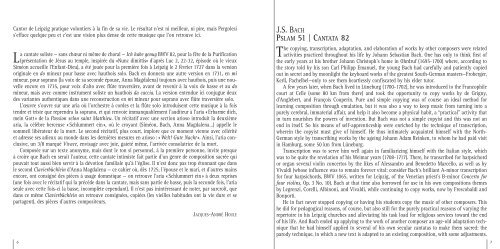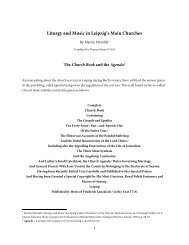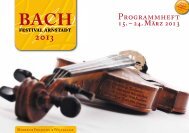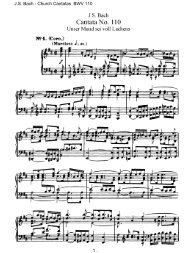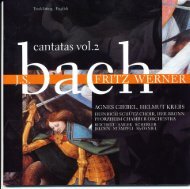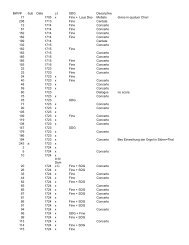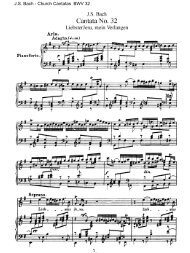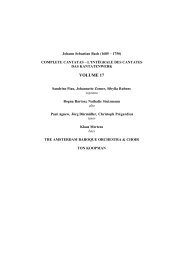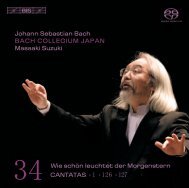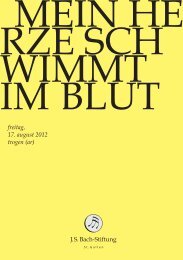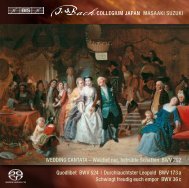Create successful ePaper yourself
Turn your PDF publications into a flip-book with our unique Google optimized e-Paper software.
Cantor de Leipzig pratique volontiers à la fin de sa vie. Le résultat n’est ni meilleur, ni pire, mais Pergolesi<br />
s’efface quelque peu et c’est une vision plus dense de cette musique que l’on retrouve ici.<br />
a cantate soliste — sans chœur ni même de choral — Ich habe genug BWV 82, pour la fête de la Purification<br />
L(présentation de Jésus au temple, inspirée du «Nunc dimittis» d’après Luc 2, 22-32, épisode où le vieux<br />
Siméon accueille l’Enfant-Dieu), a été jouée pour la première fois à Leipzig le 2 février 1727 dans la version<br />
originale en do mineur pour basse avec hautbois solo. <strong>Bach</strong> en donnera une autre version en 1731, en mi<br />
mineur, pour soprano (la voix de sa seconde épouse, Anna Magdalena) toujours avec hautbois, puis une nouvelle<br />
encore en 1735, pour voix d’alto avec flûte traversière, avant de revenir à la voix de basse et au do<br />
mineur, mais avec comme instrument soliste un hautbois da caccia. La version entendue ici conjugue deux<br />
des variantes authentiques dans une reconstruction en mi mineur pour soprano avec flûte traversière solo.<br />
L’œuvre s’ouvre sur une aria où l’orchestre à cordes et la flûte solo introduisent cette musique à la fois<br />
tendre et triste que reprendra la soprano, et qui renvoie immanquablement l’auditeur à l’aria « Erbarme dich,<br />
mein Gott » de la Passion selon saint Matthieu. Un récitatif avec une section arioso introduit la deuxième<br />
aria, la célèbre berceuse « Schlummert ein », où le croyant (Siméon, <strong>Bach</strong>, Anna Magdalena…) appelle le<br />
sommeil libérateur de la mort. Le second récitatif, plus court, implore que ce moment vienne avec célérité<br />
et adresse ses adieux au monde dans les dernières mesures en arioso : « Welt! Gute Nacht ». Ainsi, l’aria conclusive,<br />
un 3/8 marqué Vivace, envisage avec joie, gaieté même, l’arrivée consolatrice de la mort.<br />
Composée sur un texte anonyme, mais dont le ton si personnel, à la première personne, invite presque<br />
à croire que <strong>Bach</strong> en serait l’auteur, cette cantate intimiste fait partie d’un genre de composition sacrée qui<br />
pouvait tout aussi bien servir à la dévotion familiale qu’à l’église. Il n’est donc pas trop étonnant que dans<br />
le second Clavierbüchlein d’Anna Magdalena — ce cahier où, dès 1725, l’épouse et le mari, et d’autres mains<br />
encore, ont consigné des pièces à usage domestique — on retrouve l’aria « Schlummert ein » à deux reprises<br />
(une fois avec le récitatif qui la précède dans la cantate, mais sans partie de basse, puis la seconde fois, l’aria<br />
seule avec cette fois-ci la basse, incomplète cependant). Il n’est pas inintéressant de noter, par surcroît, que<br />
dans ce même Clavierbüchlein on retrouve consignées, copiées (les vieilles habitudes ont la vie dure et se<br />
partagent), des pièces d’autres compositeurs.<br />
6<br />
JACQUES-ANDRÉ HOULE<br />
J.S. BACH<br />
PSLAM 51 | CANTATA 82<br />
he copying, transcription, adaptation, and elaboration of works by other composers were related<br />
Tactivities practiced throughout his life by Johann Sebastian <strong>Bach</strong>. One has only to think first of<br />
the early years at his brother Johann Christoph’s home in Ohrdruf (1695-1700) where, according to<br />
the story told by his son Carl Philipp Emanuel, the young <strong>Bach</strong> had carefully and patiently copied<br />
out in secret and by moonlight the keyboard works of the greatest South-German masters—Froberger,<br />
Kerll, Pachelbel—only to see them heartlessly confiscated by his elder tutor.<br />
A few years later, when <strong>Bach</strong> lived in Lüneburg (1700-1702), he was introduced to the Francophile<br />
court at Celle (some 80 km from there) and took the opportunity to copy works by de Grigny,<br />
d’Anglebert, and François Couperin. Pure and simple copying was of course an ideal method for<br />
learning composition through emulation, but it was also a way to keep music from turning into a<br />
purely cerebral, immaterial affair, and help it also become a physical habit, a “practical” activity that<br />
in turn nourishes the powers of invention. But <strong>Bach</strong> was not a simple copyist and this was not an<br />
end in itself. So his means of self-apprenticeship were enriched by the technique of transcription,<br />
wherein the copyist must give of himself. He thus intimately acquainted himself with the North-<br />
German style by transcribing works by the ageing Johann Adam Reinken, to whom he had paid visit<br />
in Hamburg, some 50 km from Lüneburg.<br />
Transcription was to serve him well again in familiarizing himself with the Italian style, which<br />
was to be quite the revelation of his Weimar years (1708-1717). There, he transcribed for harpsichord<br />
or organ several violin concertos by the likes of Alessandro and Benedetto Marcello, as well as by<br />
Vivaldi (whose influence was to remain forever vital: consider <strong>Bach</strong>’s brilliant A-minor transcription<br />
for four harpsichords, BWV 1065, written for Leipzig, of the Venetian priest’s B-minor Concerto for<br />
four violins, Op. 3 No. 10). <strong>Bach</strong> at that time also borrowed for use in his own compositions themes<br />
by Legrenzi, Corelli, Albinoni, and Vivaldi, while continuing to copy works, now by Frescobaldi and<br />
Bonporti.<br />
He in fact never stopped copying or having his students copy the music of other composers. This<br />
he did for pedagogical reasons, of course, but also still for the purely practical reasons of varying the<br />
repertoire in his Leipzig churches and alleviating his task load for religious services toward the end<br />
of his life. And <strong>Bach</strong> ended up applying to the work of another composer an age-old adaptation technique<br />
that he had himself applied to several of his own secular cantatas to make them sacred: the<br />
parody technique, in which a new text is adapted to an existing composition, with some adjustments.<br />
7


